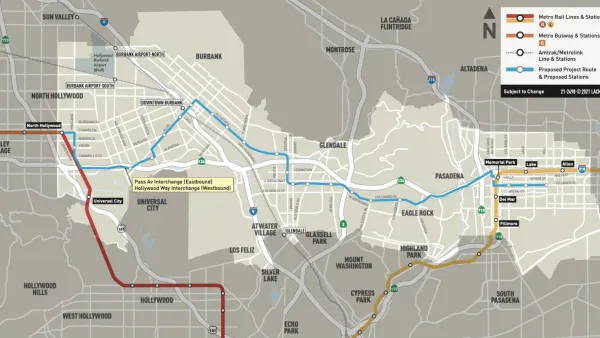Similar to microtransit on demand programs in other cities, Los Angeles' ongoing experiment is proving to be very expensive (for the public) for the benefit of very few riders.
"A half-year into Metro and Via’s year-long 'Mobility on Demand' pilot shows that ride-hail continues to be an expensive way to provide mobility for very few riders," reports Joe Linton.
The Via pilot launched in January 2019, with funding assistance from the federal government, offering on-demand, fixed-price ride-hailing services in the hopes of providing first-last mile connections to and from several specific stations in the Los Angeles County Metropolitan Transportation Authority system.
"Last month, Metro released its five-page second quarter update report showing the latest statistics for the transit-on-demand pilot," according to Linton. While ridership with the program is growing, thanks to expensive efforts to grow ridership, "total ridership is still dismal," writes Linton.
"With a $1.75 million Metro expenditure for one year – 260 weekdays in that year, Metro is spending $6,730 per day for these rides. 1,675 rides per week translates to 335 rides per day. 335 rides for $6,730 means that each ride is costing Metro $20.09 (that is just Metro’s cost – these also cost FTA and forgo Via’s “risk sharing”)."
FULL STORY: Six Months in, Metro/Via Mobility on Demand Pilot is an Expensive Flop

National Parks Layoffs Will Cause Communities to Lose Billions
Thousands of essential park workers were laid off this week, just before the busy spring break season.

Retro-silient?: America’s First “Eco-burb,” The Woodlands Turns 50
A master-planned community north of Houston offers lessons on green infrastructure and resilient design, but falls short of its founder’s lofty affordability and walkability goals.

Delivering for America Plan Will Downgrade Mail Service in at Least 49.5 Percent of Zip Codes
Republican and Democrat lawmakers criticize the plan for its disproportionate negative impact on rural communities.

Test News Post 1
This is a summary

Test News Headline 46
Test for the image on the front page.

Balancing Bombs and Butterflies: How the National Guard Protects a Rare Species
The National Guard at Fort Indiantown Gap uses GIS technology and land management strategies to balance military training with conservation efforts, ensuring the survival of the rare eastern regal fritillary butterfly.
Urban Design for Planners 1: Software Tools
This six-course series explores essential urban design concepts using open source software and equips planners with the tools they need to participate fully in the urban design process.
Planning for Universal Design
Learn the tools for implementing Universal Design in planning regulations.
EMC Planning Group, Inc.
Planetizen
Planetizen
Mpact (formerly Rail~Volution)
Great Falls Development Authority, Inc.
HUDs Office of Policy Development and Research
NYU Wagner Graduate School of Public Service




























